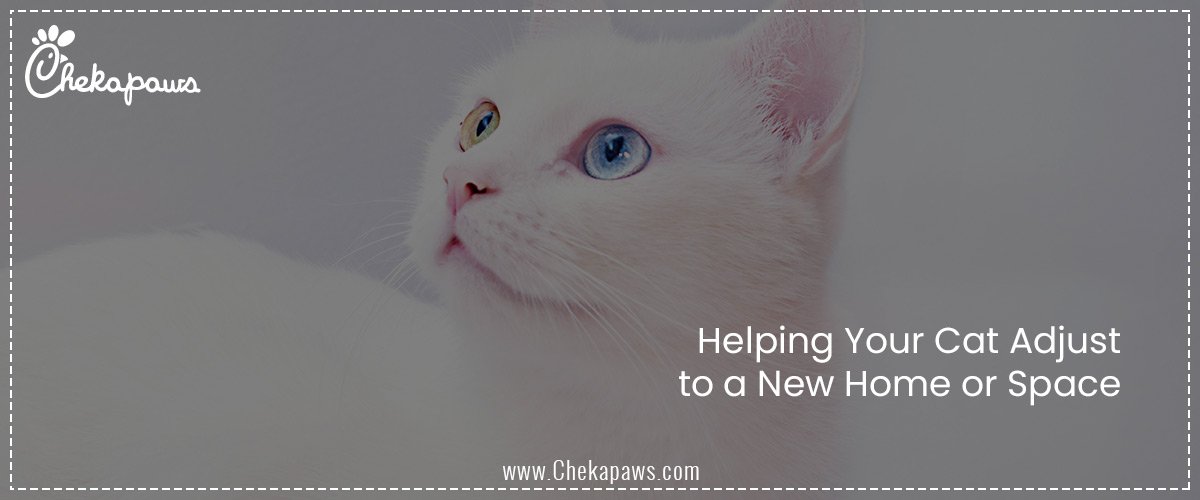As a pet parent, I am aware that moving to a new residence is one of the most significant life transitions, both for you and your feline companion. Cats are naturally territorial creatures, and the familiar sights, sounds, and smells of their usual surroundings provide them a sense of security. When all of that changes at once, it may cause behavioral issues, bewilderment, or anxiety.
Understanding your cat’s instincts, offering comfort, and creating an environment that encourages trust and security are all important aspects of assisting them in adjusting to a new home. It goes beyond simply unpacking their food bowl and litter box.
Everything you need to know about facilitating your cat’s move to a new home will be covered in this guide, including how to prepare, settling-in techniques, create a comfortable environment, and deal with any obstacles that may come up.
Table of Contents

Understanding the Cat Perspective
You must view the move via your cat’s eyes before you can help them in adjusting.
Territory and Cats
Cats have a strong sense of territoriality. Their “safe zone,” which they have designated and marked with their smell, is the center of their universe. They find routine, security, and comfort in this domain.
Everything they always trusted vanishes when they relocate; the layout is altered, the scent markings are gone, and there are strange noises and scents everywhere. Your cat feels as if they have lost control of their environment.
Stress Triggers During a Move
Stress in cats during relocation can be caused by the following
- Loud sounds (cars, movers, packing)
- People coming into their new or old space
- Disturbance in the routine (feeding schedules, sleeping locations)
- Loss of hiding places and recognizable scents
- Exposure to strange smells or new creatures
Behavioral Signs of Stress
- A cat under stress could
- Stay hidden over extended periods of time.
- Don’t eat or drink anything.
- Excessive grooming or shedding
- Excessive vocalization, particularly at night
- Use the litter box sporadically.
- Act hostile or withdrawn
- Knowing these signs enables you to take early action before anxiety worsens and develops into persistent behavioral problems.
Preparing for the Move: Before You Leave
It’s all about preparation. Your cat will be less stressed if the procedure goes more smoothly.
Maintain as Normal a Routine as You Can
- During the weeks before your move:
- Keep your play and eating schedules consistent.
- Don’t introduce new brands of toys or litter.
- Your cat will link confinement or kennel with worry if you do it too soon.
- They are reassured by consistency that life is still predictable.
Introduce the Carrier Early
- Before moving day, begin transforming your cat’s carrier into a secure environment if they don’t enjoy it
- Keep it open in a peaceful place with cozy bedding.
- To create pleasant connections, put toys, catnip, or goodies inside.
- For brief intervals, gradually close the door while praising or providing food.
- This step prevents panic during transport.
Vet Check-Up and Identification
Make an appointment for a pre-move vet visit
- Verify that immunizations and parasite control are current.
- Talk about anti-anxiety options, such as pheromones, vitamins, or, if necessary, light medication.
- Put your new address on your cat’s collar tag and microchip.
Packing with Care
Long before the transfer, cats are able to feel what is happening. Make an effort to
- Pack little rather than everything at once.
- Don’t touch your cat’s space until the very last minute.
- Scent continuity is important, so don’t wash their favorite blanket or bed.
Safe Room Strategy
Create a “safe room” for your cat in a peaceful area of the house if movers are coming and going. It should include
- Litter box
- Food and water bowls
- Toys
- Carrier
- Familiar bedding
To stop people from accidentally opening the door, label it.
The Big Day Moving with Your Cat
The day of the move is chaotic. Reducing your cat’s stress is essential.
Getting Ready to Travel
- A few hours prior to leaving, give your cat a light meal; avoid giving them a large meal to avoid nausea.
- Use bedding that absorbs to line the carrier.
- To prevent visual stresses, place a light blanket over the carrier.
- Fifteen minutes prior to departure, use a feline pheromone spray (such as Feliway) inside the carrier.
During the Move
- Until you’ve established your cat’s sanctuary and entered the new house, keep them in their carrier.
- Don’t open the carrier outside because even peaceful cats can run away in terror.
- When interacting with your cat, use soothing, quiet voices.
Arrival at the New Home
When you get there
- As soon as possible, put your cat in their assigned safe room.
- Before opening the carrier, arrange the necessities: food, water, and a litter box.
- Allow your feline to explore the space at their own pace.
- Remain close by, talking quietly, but initially avoiding excessive handling.
The First Few Days: Settling In
Your cat’s mental and physical adjustment during these first few days is essential.
First, establish a little territory
Allow your cat to occupy one room before granting them access to the rest of the house. They feel safer in this more controlled, smaller area. Expand access gradually after they feel comfortable doing so.
Scent Identification
- For a cat, scent is everything. Make use of the following tactics:
- After stroking your cat’s cheeks with a gentle cloth, move it to furniture, doorways, and corners.
- Combine new areas with old bedding.
- Avoid harsh cleaning agents that can destroy your cat’s scent indicators.
Keep Things Quiet – Limit guests and noise during the first week. Wait until your cat shows signs of confidence before introducing loud equipment or other pets.
Maintain Routine – Give your cat food at certain times throughout the day. Stability and predictability are communicated by routine.
Play Therapy – Playtime lowers anxiety. To help your cat relax and form a bond with you in their new surroundings, use interactive toys like feather wands or laser pointers.
Sleeping Arrangements – When cats are nervous, they frequently decide to sleep close to their owners. Sharing your space with your cat can improve your relationship and provide you peace of mind.
Gradual Exploration: Expanding Territory
It’s time to step outside your cat’s secure sanctuary after they are eating regularly and displaying curiosity.
Supervised Exploration
One room at a time, let your cat explore. To limit access and avoid overload, keep doors closed.
Ensure each room has
- A concealing place (such as within a box or beneath furniture)
- Cat trees or elevated surfaces
- Familiar fragrances
These areas give cats the ability to retreat and exert control over their surroundings, two essential elements of feline confidence.
Avoid Forced Contact – Let your cat take the lead. Never move them to different rooms or pick them up. Instead, let their innate curiosity lead the way.
Use Pheromone Diffusers – Pheromone diffusers can be plugged into several rooms. These synthetic soothing cues help cats relax by simulating the natural fragrance of a mother cat.
Introducing Other Pets (If Applicable)
Slow and controlled introductions are necessary if you have other pets.
Scent First, Sight Later
- Start by exchanging scents
- Switch toys or blankets amongst the animals.
- Place one pet next to the other’s space and rub it with a soft cloth.
- Once they both appear at ease with one another’s scent, move on to visual introductions via a door crack or gate.
Controlled Meetings
The initial conversation should be quiet and brief.
- Give treats to calm behavior as a reward.
- Leash dogs, and let cats back off if necessary.
- Patience is crucial; never try to force interaction.
Monitor for Stress – Keep an eye out for avoidance, snarling, or hissing. If tensions increase, take a step back and always put the comfort of the new cat first.
Helping Your Cat Adjust Emotionally
Positive Reinforcement – Give mild praise or treats to encourage peaceful exploration, eating, and play. In their new home, cats discover that positive things happen.
Activities for Bonding – Take some peaceful time to read or work in the safe room. Your calm attitude helps in their comfort association with the new area.
Environmental Enrichment
Give your cat mental stimulation by
- Puzzle feeders
- Window perches or cat trees
- Posts that scratch
- Keeping sweets hidden throughout the room
- Through these activities, curiosity and confidence take the place of dread.
Handling Regression – Cats can experience a brief relapse, returning to hiding after making progress. Do not panic. Keep reassuring them calmly and refrain from reprimanding or pursuing them.
Common Challenges and How to Overcome Them
Not Eating
Get in touch with your veterinarian right once if your cat stops eating for longer than twenty-four hours. Consider providing
- Warm, moist food has a greater scent.
- The old house’s favorite treat for them
- Small bites are hand-fed to foster trust.
Avoiding Litter Boxes
This is typical following a move. Verify
- The location of the box is peaceful and uncrowded.
- You’re using the same brand of litter.
- Each cat has a box, plus an additional one.
- Instead of punishing them, rule out medical problems or stress.
Excessive Hiding – Let it happen, but keep a tight eye on it. Talk quietly while placing food and water close to where they are hiding. Curiosity will eventually triumph over fear.
Aggression or Fear-Based Behavior – Never react aggressively. If your cat lashes out, put some distance between you and them, talk softly, and use calming pheromones. If aggression continues, get advice from a feline behaviorist.
Long-Term Adjustment (Weeks to Months)
Naturally Marking Territory – Your cat uses digging, scratching, and rubbing as a means of expressing their ownership and sense of security.
Developing Self-Belief – You gain confidence by being predictable. After the relocation, continue feeding, playing, and resting at regular intervals for at least two to three months.
Access to the outdoors (if applicable)
Wait at least three to four weeks before allowing your cat outside if they have been outside in the past. Constantly
- First, supervise.
- To make it easier for them to return, let them out before meals.
- Start with brief sessions and work your way up.
Monitor Health – Immunity, digestion, and appetite can all be affected by stress. Keep an eye out for overgrooming, diarrhea, or vomiting. Consult a veterinarian if symptoms continue.
Special Considerations
Kittens – Although they may adapt, young cats are easily terrified. Use gentle introductions, keep them confined for extended periods of time, and give them lots of playing to strengthen their bonds.
Senior Cats – Change may be more difficult for older cats. Provide comfortable beds, reduce noise, and think about heating pads or ramps that are easy on the joints.
Cats in Shelters or Rescue – Adoption and moving at the same time need for special attention. Since many shelter cats have traumatic pasts, consistency and patience are key to fostering trust.
Creating a Cat-Friendly Home Design
Vertical Territory – Put in window perches, shelves, or cat trees. Cats who are taller feel more confident and can observe comfortably.
Places to Hide – Include comfortable areas such as cardboard boxes, tents, or cat cubes. Cats require safe havens.
Opportunities for Scratching – In addition to identifying territory, scratching posts help reduce stress. Provide both horizontal and vertical options.
Window Views – Cats enjoy looking out at the world. Create secure viewing areas to cut down on boredom.
Avoid Clutter – Cats become overwhelmed by clutter or too much change. Avoid moving furniture around a lot and maintain open, predictable areas.
When to Seek Professional Help
If your cat is
- Refuse to eat for more than 24 hours
- Displays a persistent fear or aggressiveness
- For weeks, it eliminates outside the litter box.
- Shows symptoms of illness or disengagement
- It’s time to speak with a licensed feline behaviorist or your veterinarian.
- Expert advice can determine if the problem is medical or behavioral and customize a course of treatment.
Patience and Love: The Key to Success
- Although their stamina, cats require time and comfort. While some adjust in a matter of days, others require weeks or months. Your consistency, empathy, and patience are what really count.
- Your relationship is strengthened and their trust is restored with each reassuring word, tender touch, and consistent pattern.
- Keep in mind that your cat needs to feel at home again, not just a new home.
Conclusion
A journey of understanding, patience, and empathy is required to help your cat become used to a new home or environment. You’re providing your cat with the consistency they need by carefully planning, sticking to routines, and creating a safe space.
Your kitty companion is regaining trust in their environment and in you with each purr, careful paw step, and meow.
This unfamiliar place will eventually become a familiar one, full of love, warmth, and company. Your cat will not only adjust to their new home but thrive there with your help.







